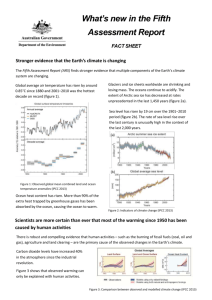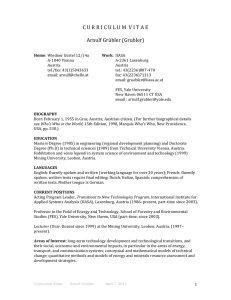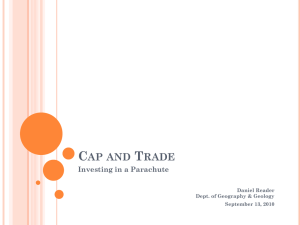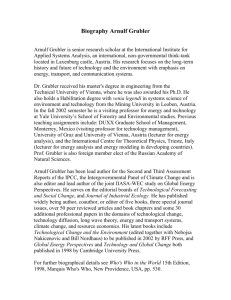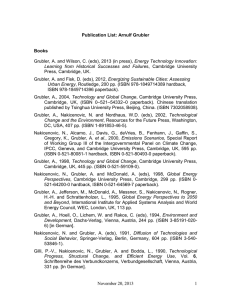M. Obersteiner, * International Institute of Applied Systems Analysis
advertisement
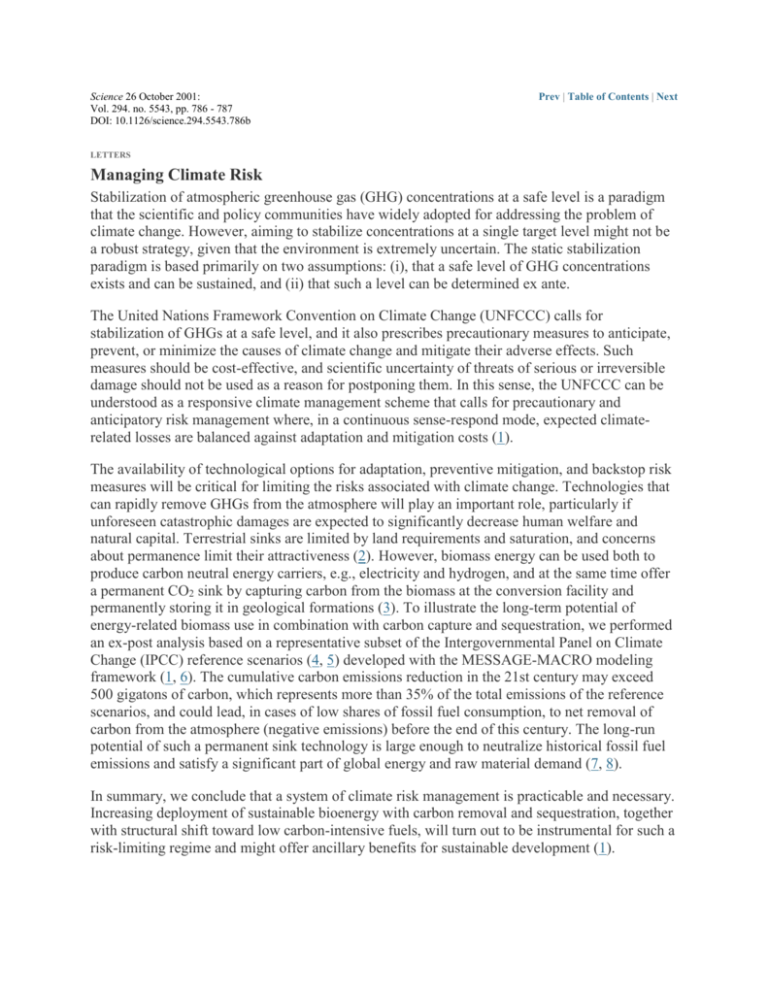
Science 26 October 2001: Vol. 294. no. 5543, pp. 786 - 787 DOI: 10.1126/science.294.5543.786b Prev | Table of Contents | Next LETTERS Managing Climate Risk Stabilization of atmospheric greenhouse gas (GHG) concentrations at a safe level is a paradigm that the scientific and policy communities have widely adopted for addressing the problem of climate change. However, aiming to stabilize concentrations at a single target level might not be a robust strategy, given that the environment is extremely uncertain. The static stabilization paradigm is based primarily on two assumptions: (i), that a safe level of GHG concentrations exists and can be sustained, and (ii) that such a level can be determined ex ante. The United Nations Framework Convention on Climate Change (UNFCCC) calls for stabilization of GHGs at a safe level, and it also prescribes precautionary measures to anticipate, prevent, or minimize the causes of climate change and mitigate their adverse effects. Such measures should be cost-effective, and scientific uncertainty of threats of serious or irreversible damage should not be used as a reason for postponing them. In this sense, the UNFCCC can be understood as a responsive climate management scheme that calls for precautionary and anticipatory risk management where, in a continuous sense-respond mode, expected climaterelated losses are balanced against adaptation and mitigation costs (1). The availability of technological options for adaptation, preventive mitigation, and backstop risk measures will be critical for limiting the risks associated with climate change. Technologies that can rapidly remove GHGs from the atmosphere will play an important role, particularly if unforeseen catastrophic damages are expected to significantly decrease human welfare and natural capital. Terrestrial sinks are limited by land requirements and saturation, and concerns about permanence limit their attractiveness (2). However, biomass energy can be used both to produce carbon neutral energy carriers, e.g., electricity and hydrogen, and at the same time offer a permanent CO2 sink by capturing carbon from the biomass at the conversion facility and permanently storing it in geological formations (3). To illustrate the long-term potential of energy-related biomass use in combination with carbon capture and sequestration, we performed an ex-post analysis based on a representative subset of the Intergovernmental Panel on Climate Change (IPCC) reference scenarios (4, 5) developed with the MESSAGE-MACRO modeling framework (1, 6). The cumulative carbon emissions reduction in the 21st century may exceed 500 gigatons of carbon, which represents more than 35% of the total emissions of the reference scenarios, and could lead, in cases of low shares of fossil fuel consumption, to net removal of carbon from the atmosphere (negative emissions) before the end of this century. The long-run potential of such a permanent sink technology is large enough to neutralize historical fossil fuel emissions and satisfy a significant part of global energy and raw material demand (7, 8). In summary, we conclude that a system of climate risk management is practicable and necessary. Increasing deployment of sustainable bioenergy with carbon removal and sequestration, together with structural shift toward low carbon-intensive fuels, will turn out to be instrumental for such a risk-limiting regime and might offer ancillary benefits for sustainable development (1). M. Obersteiner,* International Institute of Applied Systems Analysis, A-2361 Laxenburg, Austria. Institute for Advanced Studies, A-1060 Vienna, Austria. Ch. Azar, Chalmers University of Technology, Sweden. P. Kauppi, International Institute of Applied Systems Analysis, A-2361 Laxenburg, Austria. K. Möllersten, Royal Institute of Technology, Sweden. J. Moreira, University of São Paulo, Brazil. S. Nilsson, International Institute of Applied Systems Analysis, A-2361 Laxenburg, Austria. P. Read, Massey University, New Zealand. K. Riahi, International Institute of Applied Systems Analysis, A-2361 Laxenburg, Austria. B. Schlamadinger, Joanneum Research, Austria. Y. Yamagata, National Institute for Environmental Studies, Japan. J. Yan, Royal Institute of Technology, Sweden. Shanghai Jiaotong y. Yamagata University, China. J.-P. van Ypersele, Université catholique de Louvain, Belgium * To whom correspondence should be addressed. E-mail: oberstei@iiasa.ac.at References and Notes 1. M. Obersteiner et al., in preparation. Draft available at http://www.iiasa.ac.at/Research/FOR/ 2. B. Schlamadinger, G. Marland, Land Use & Global Climate Change: Forests, Land Management and the Kyoto Protocol (Pew Center on Global Climate Change, Arlington VA, 2000); available athttp://www.pewclimate.org/projects/land_use.cfm 3. K. Möllersten, J. Yan, World Resour. Rev., in press. 4. IPCC, Special Report on Emissions Scenarios (SRES): A Special Report of Working Group III of the Intergovernmental Panel on Climate Change (Cambridge Univ. Press, Cambridge,\ 2000). 5. K. Riahi, R. A. Roehrl, Environ. Econ. Policy Stud. 3 (no. 2), 89 (2000). 6. S. Messner, L. Schrattenholzer, Energy 25, 267 (2000). 7. IPCC, Climate Change 2001: Mitigation, Third Assessment Report, Working Group III of the Intergovernmental Panel on Climate Change (Cambridge Univ. Press, Cambridge, UK, 2001). 8. G. Fischer, L. Schrattenholzer, Biomass Bioenergy 20, 151 (2001).

